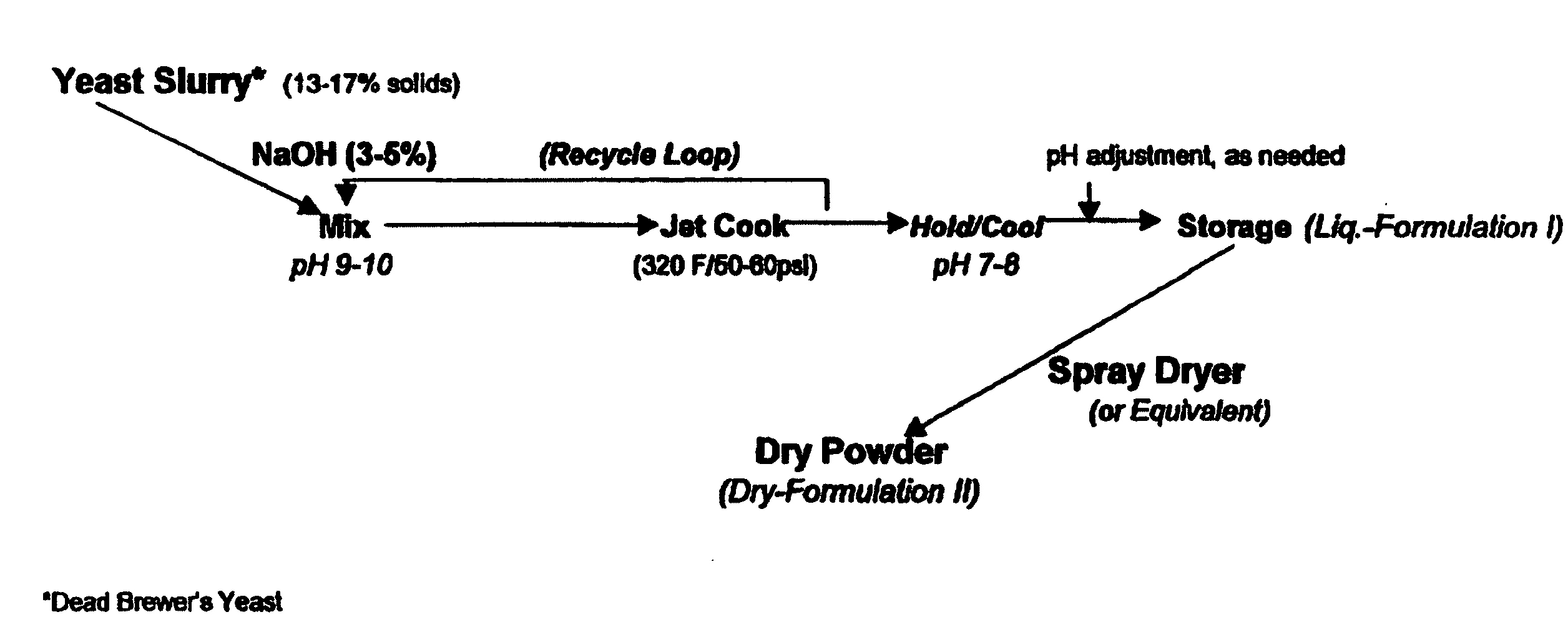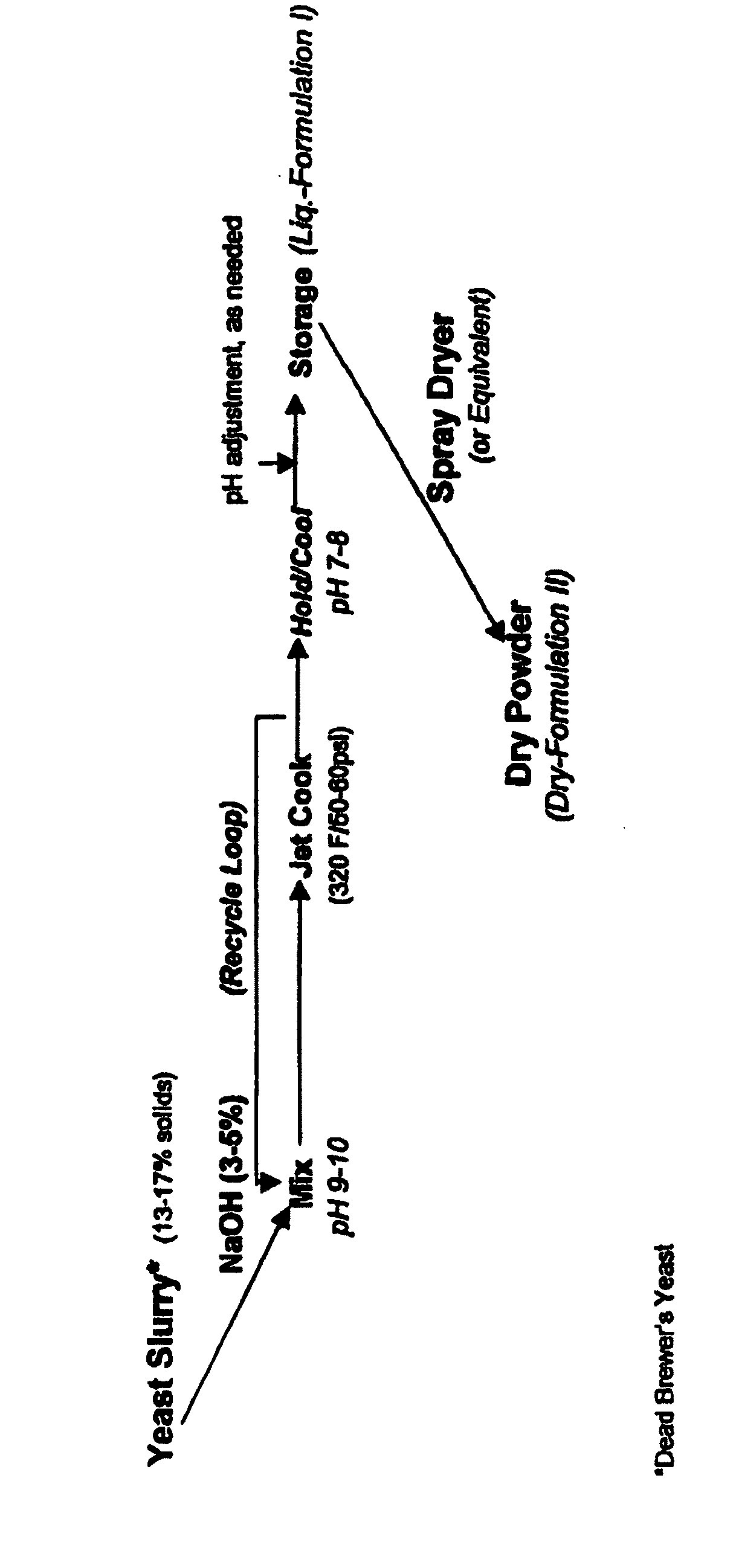Method for Dissociation of Cells
a cell and cell wall technology, applied in the field of cell dissociation, can solve the problems of cell to different stresses, cell wall rupture, and difficulty in commercializing the extraction of nutrients from cells
- Summary
- Abstract
- Description
- Claims
- Application Information
AI Technical Summary
Benefits of technology
Problems solved by technology
Method used
Image
Examples
example 1
[0031]This Example illustrates the jet cooking of dried yeast cells in a skid-mounted jet cooking pilot scale apparatus.
[0032]About 1.8 kg of commercial spray-dried dead Brewer's yeast was added to about 10 L of cold water with agitation in a mixing tank. After about 5 minutes an additional quantity of water was added to bring the final volume to about 12 L. The slurry was allowed to mix for another 3 to 5 minutes at which time about 500 ml of about 20% concentrated sodium hydroxide was slowly added to the yeast slurry. The agitation was adjusted to high speed mixing during and immediately following the alkaline addition. The moisture was allowed to mix at the high speed for another 5 to 10 minutes whereupon the pH was checked. The measurement showed that the pH had increased to about 9.2. Another small addition of 20% sodium hydroxide was used to increase the pH to about 9.7. The slurry was allowed to mix for another 3 minutes or so at a high rate of speed at which time the agitati...
example 2
[0036]A post-distillation fermentation broth from an ethanol production plant was centrifuged and the solids recovered as a slurry. This slurry was composed of about 20% solids which included primarily (80 to 90%) dead Brewer's yeast cells. The slurry was spray-dried in a pilot plant dryer and stored at room temperature. This material was later retrieved from storage and processed employing the general parameters and multiple pass jet cook procedures outlined in Example 1 and illustrated in FIG. 1 using the skid mounted laboratory / pilot plant jet cooking apparatus.
[0037]The observations and results of this experiment were consistent with other experiments performed in this manner. Specifically, some (10-20%) dead yeast cell wall dissociation, an increase in viscosity, and a decrease in pH were observed in the first jet cooker pass. Immediately following the first pass of the entire sample volume, this material was transferred back to the jet cooker feed tank and cycled through again...
example 3
[0038]This example illustrates the purification of fungal chitin using the method of the invention and a substantially uniform microbial fungal source.
[0039]A fungal biomass such as Aspergillus niger or Aspergillus oryzae is concentrated (or dewatered) using a known procedure such as evaporation, centrifugation and the like to about 12 to 17% solids. The pH of the slurry is adjusted to about pH 11 to 12 with about 5 to 10% sodium hydroxide. The slurry is then jet cooked at 320° F., 50 to 60 psi. The first pass is collected and the pH readjusted to 11 to 12, as needed. This material is then subjected to as many jet cook cycles at the strongly alkaline pH as required to effect hydrolysis of as much of the protein, lipids, glucan and other biomolecules as possible. The treated material is next filtered using vacuum filtration or a related procedure to remove denatured biomolecules and undesirable materials. The filtered (or alkali insoluble) material is washed with water, the pH is adj...
PUM
 Login to View More
Login to View More Abstract
Description
Claims
Application Information
 Login to View More
Login to View More - R&D
- Intellectual Property
- Life Sciences
- Materials
- Tech Scout
- Unparalleled Data Quality
- Higher Quality Content
- 60% Fewer Hallucinations
Browse by: Latest US Patents, China's latest patents, Technical Efficacy Thesaurus, Application Domain, Technology Topic, Popular Technical Reports.
© 2025 PatSnap. All rights reserved.Legal|Privacy policy|Modern Slavery Act Transparency Statement|Sitemap|About US| Contact US: help@patsnap.com


